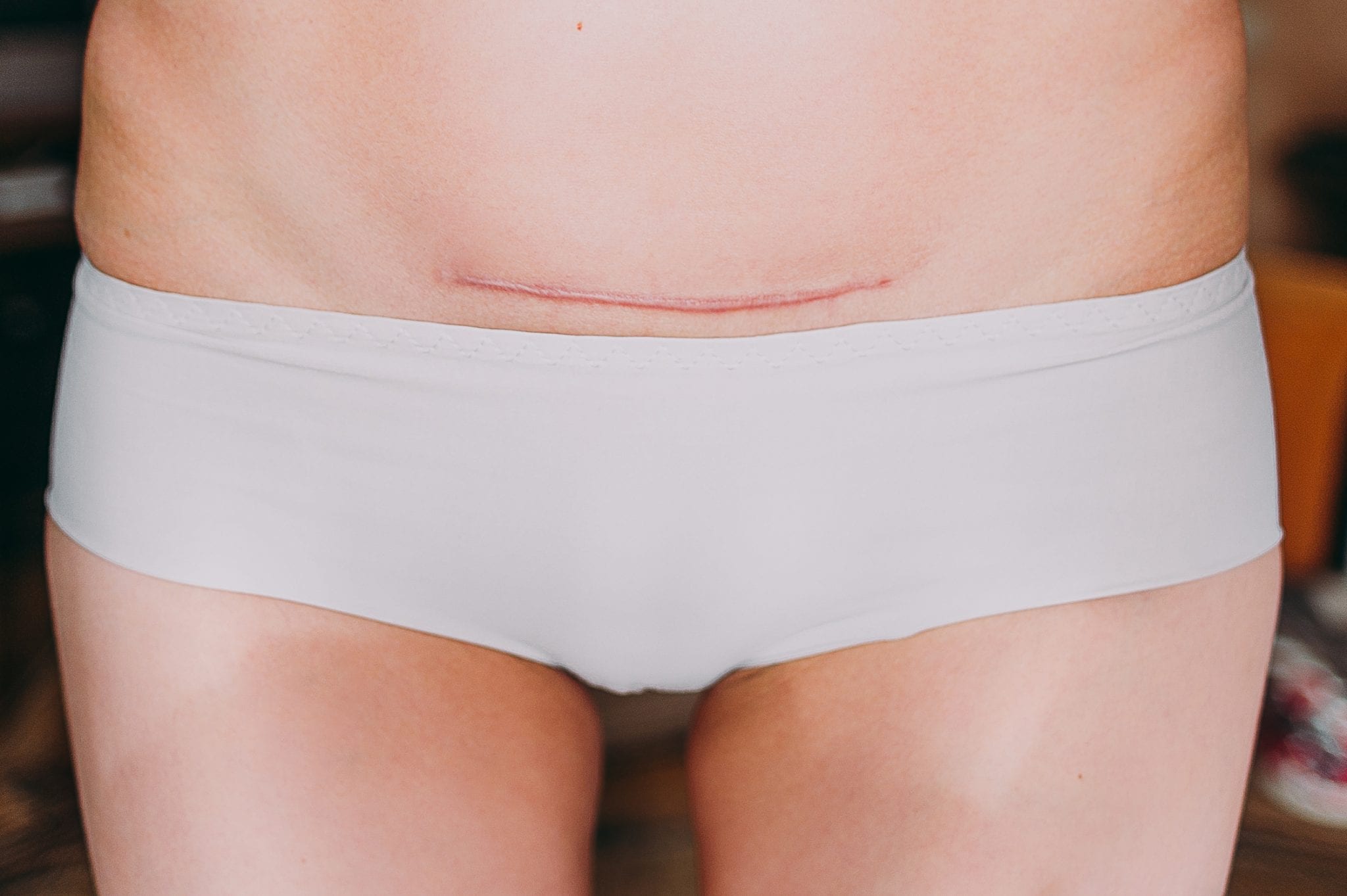C-section, cesarean section, or belly birth — however you relate to it — can be planned or unplanned. During the C-section, your doctor makes an incision into the skin, through the fat cells and connective tissue, and then into the abdominal cavity. Your doctor then spreads the abdominal muscles apart and moves the bladder out of the way to reach the uterus. Then, they make an incision into the uterus, and your baby is guided out. Shortly after your baby is delivered, your birthing team removes the placenta. The uterus is then stitched up, and they stitch up your connective tissue, abdominals, and skin to varying degrees. C-sections require a lot of layers of sutures, which can lead to the formation of scar tissue.2
Understanding how your body heals from this surgery is essential to best care for yourself and support your tissues in their healing. That’s why we’ve prepared this week-by-week guide on C-section recovery!
Week-by-Week C-Section Recovery Timeline
Every recovery is unique, but this week-by-week timeline outlines what many C-section moms experience — and how to care for your body each step of the way.
Week 1: C-Section Recovery
The first week after your C-section, you can expect to feel some numbness and soreness at the incision site. It’s normal for your scar to be slightly raised, puffy, and even darker than your normal skin tone, so don’t be alarmed. Generally, your doctor will watch your healing process and give at-home care instructions to ensure your wound heals properly.3 They may also recommend some of these C-section recovery must-haves. When coughing, sneezing, or laughing, make sure to support the incision site by bracing your abs (imagine pulling your belly button to your spine). You can also apply gentle pressure to the incision site with your hand.
For the first few weeks after giving birth, you’ll have a vaginal discharge called lochia. Lochia consists of blood, bacteria, sloughed-off tissue from the lining of your uterus, and normal bleeding. This is true for women who deliver by C-section or vaginally. The discharge will be bright red for the first couple of days.1 You might also have some gas pain and bloating during the first two days. Gas tends to build up because the intestines are sluggish after surgery. Getting up and moving around will help your digestive system get going again.3,4
Walking Around
On the day of or after surgery, you’ll be encouraged to get out of bed at least a few times to walk around and get your blood pumping. Wiggling your feet, rotating your ankles, and moving and stretching your legs are great ways to do this. Walking to the bathroom may seem impossible initially, but moving around is important for your C-section recovery. You want to ensure you keep your blood circulating to minimize your chances of developing blood clots.3 Also, walking will make your bowels less sluggish, which will help you feel more comfortable sooner.11 For these reasons, you’ll be encouraged to walk every day. Consider going for your walks shortly after you’ve taken pain medication so that you feel less discomfort during your outing.
Urinating
It’s also important to urinate regularly. A full bladder increases pressure on your C-section wound, which may lead to more discomfort.5 Your discharge and bleeding will diminish, but both can last up to six weeks.6
Bleeding and Clotting
Discharge and bleeding should gradually turn from bright red to pink and then yellow-white. Call your healthcare provider if menstrual-type bleeding continues past the first four days after delivery or comes back after slowing.6 And immediately call your doctor if you have any signs of a blood clot. This includes severe or persistent pain or tenderness and warmth in one area of your leg or one leg that’s more swollen than the other.12
Weeks 2–6: Healing and Gradual Activity
Many women forget that a cesarean is a major operation. You should focus on healing and recovery during the first six weeks after the surgery. Don’t push your body too far and too fast! Generally, most doctors recommend easing back into exercise or heavy lifting six to eight weeks post-surgery. Still, you can begin pelvic floor exercises and core breathing immediately.1
Pelvic Floor Exercise
Every time you lift your baby, tighten your pelvic floor muscles and lower tummy muscles simultaneously. This will help protect your back and prevent you from leaking urine.7,13 In the early days, you can reprogram your core to function from the diaphragm down through the trunk to the pelvic floor muscles. You can do this by practicing your core breathing from a supine position and, when comfortable, in a seated position.14
Core Breathing
Core breathing is simple. When you inhale, feel your ribcage, belly, and pelvic floor expand and gently relax. Then, on your exhale breath, purse your lips (like you’re blowing through a straw) and gently exhale to encourage activation through the pelvic floor and deep abdominal muscles.14 Before doing any activity (even before picking up your baby), pull in your abdomen, exhale your core breath, get deep tension and support in the pelvic floor, and then begin the movement or lift.13,15
Once you feel comfortable with pelvic floor exercises, you can also start working on your lower tummy muscles, which will help strengthen your back. Try this simple and safe exercise 10 times, twice a day, gradually building up to three times daily.15 If you find it difficult, start with five times, twice a day.
Note: This gentle core breathing exercise is safe and won’t hurt your stitches or scar. There’s no need to wait unless it feels painful. The tissues around your scar will benefit from you gently flexing them. Standing up straight and doing gentle abdominal squeezes will help your scar knit together.
During the first six weeks after having your baby, you can gradually increase activity at a pace that feels good to you. But cut yourself some slack; this isn’t the time to jump back into the workouts you did before or during pregnancy. Your body needs to heal and recover. So, start with a five-minute walk.8 Once you feel comfortable with that time and distance, extend your walk to 10 or 15 minutes. Ask your doctor if you’re unsure about any specific exercise or activity and how it will affect your healing.
Week 6 and Beyond: Final Stage of C-Section Recovery
Your healing process isn’t over just because you hit the six-week mark. Getting “cleared” for exercise by your doctor doesn’t mean your body has completely healed from pregnancy and delivery. Start with activities that help you build a strong foundation and slowly tone and flatten your tummy. Then, when you’re ready and able, ease yourself back into weight training exercises and sprints.9 (Read postpartum workout basics every new mom should know.)
Sprints, metabolic conditioning, and proper weight training are great ways to shed some of the baby weight. You may only be able to do 10 minutes in the beginning, but you will get stronger — trust me. Just remember, pregnancy hormones can affect your joints for up to six months after birth, so stay away from high-impact activities. This is a process!9
Ab Work and Diastasis Recti
Many new moms want to return to the gym and start crunching away and working their abs, but this is a BIG mistake. Rigorous ab routines can do more harm than good, causing pelvic floor and intra-abdominal pressure.15
Some women develop a gap in their abdominal muscles as their bellies expand during pregnancy and labor, a condition called diastasis recti. Intra-abdominal pressure from ab work can cause the diastasis (or gap) to worsen and injure those muscles. Before starting any ab routine, use caution and check the condition of your stomach muscles.10
We know that recovering from a C-section can be tough for some and easier for others. Either way, it’s a time to focus on you, your baby, and your recovery. With this week-by-week C-section recovery guide, we hope you found the information you were looking for and leave feeling prepared for your time after childbirth!










